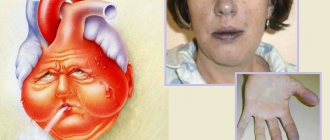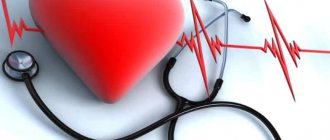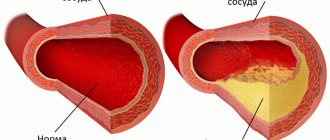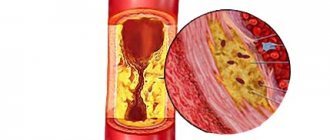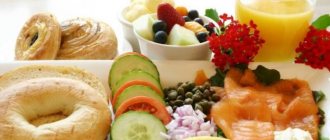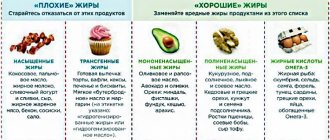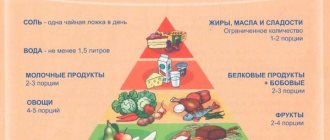Nutritional therapy is included in the treatment regimen for most diseases. Diet for cardiovascular diseases is not one of the main methods of treatment, for example, as in cases of diabetes, metabolic syndrome, gastrointestinal pathologies, and kidney problems.
Healthy eating pyramid
Changing the eating behavior of heart patients, hypo- or hypertensive, is not only recommended, but also indicated. Moreover, the main contingent with such diagnoses are elderly people.
Even without any special health problems, they need to reconsider the usual diet that they followed in adulthood.
Basic diet for heart and vascular diseases
A properly prescribed diet for cardiovascular diseases can enhance the effect of medications and even prolong life. A healthy table can serve as a preventive measure, especially if there are certain risks, for example:
- patient age over 40 years;
- heredity;
- tobacco use;
- excessive doses of alcoholic beverages;
- high blood pressure;
- poor nutrition;
- obesity;
- diabetes mellitus;
- sedentary lifestyle.
A diet for cardiovascular diseases can improve metabolism, reduce the load on the heart, and also enhance the effect of medications.
Before the doctor prescribes any treatment, the patient is thoroughly examined. The stage of the disease, the condition of the intestines, as well as other ailments or disorders are revealed.
First of all, the patient must learn to eat small and often meals, drink a minimum of liquid, and also eliminate salt. Vitamins and potassium salts should be included in the diet for diseases of the cardiovascular system.
Depending on the severity of the disease, patients are prescribed diets numbered 10, 10 A, 10 C, 10 I, as well as potassium, vegetable and fruit, hyposodium, etc.
Diet table No. 10 is prescribed:
- for various heart defects;
- with atherosclerosis;
- after heart attacks;
- for rheumatism.
Following this diet will help restore blood circulation, metabolic processes, and also improve liver and kidney function. The main principles of diet table No. 10 include the following:
- The diet should be varied.
- Excluding plant fiber from it.
- Eating foods that normalize fat metabolism.
- Fractional meals (5-6 times) in small portions.
- Mandatory consumption of foods that contain alkaline compounds, vitamins, macro- and microelements.
A diet for cardiovascular diseases can be classified as a nutritious diet. The main thing is that you should not consume foods that contain substances that excite the nervous system, for example, strong teas, coffee or fatty broths. Daily calorie content is 2800 kcal. Food with minimal salt content. It should be boiled, baked or steamed.
Video on the topic
We also recommend that you watch the video below:
So, adhering to the rules of food consumption, limiting alcohol, fat, quitting smoking, enriching the body with vitamins can not only protect against problems with the cardiovascular system, but also correct the consequences of previous or ongoing diseases. When compiling a diet, it is important to take into account the individual characteristics of the body and the digestibility of food.
By the way, digestibility increases sharply when food intake is systematized and sleep patterns are maintained. It is important to walk more, pay attention to the environment, and eliminate stress. It is important to remember that the heart and blood vessels must be treated with care, rest more, without forcing the body systems to work for wear. It is difficult to restore the cardiovascular system, but it is possible, and it is much easier to save it.
Allowed products for diseases of the heart and blood vessels
A fairly common question: “What can you eat if you have cardiovascular diseases?” Nutritionists consider the following to be the main products:
- Bread made from wheat flour or bran (slightly dried), white or gray crackers, as well as sponge cake made from soft dough.
- Vegetable, cereal or dairy soups with minimal salt content.
- For meat, it is better to choose rabbit, lean beef or veal. From poultry - turkey or chicken. From fish - bream, cod, pike perch or carp.
- Vegetables are eaten boiled, raw or baked.
- Cereal porridge.
- Pasta as a side dish.
- Be sure to include fresh salads and seafood salads in your diet.
- You can eat cabbage and potatoes, but in very limited quantities.
- Dairy products.
- Chicken eggs, but no more than two per day.
- Raw or processed fruits, dried fruits.
- Weakly brewed coffee with added milk, weak tea, compotes, jelly or self-prepared juices.
What can be included in the menu for the week
Normalizing blood circulation and metabolic processes, reducing the load on the kidneys and facilitating the functioning of the digestive system, eliminating swelling and shortness of breath - these are the main tasks that need to be solved by people with heart and vascular diseases.
You can find out what dishes can be included in the menu for week 10 of the diet for cardiovascular diseases from the list below.
Breakfast can be divided into two meals and prepared:
- oatmeal, buckwheat or semolina porridge;
- omelet or soft-boiled egg;
- toast (cracker);
- low-fat cheese;
- low-fat curd mass;
- fruits;
- Tea with lemon.
Lunch may consist of the following dishes:
- lean borscht (cabbage soup);
- rice soup;
- vegetable stew;
- mashed potatoes;
- squash caviar;
- boiled or baked chicken or fish;
- fruit dessert.
For afternoon tea you can offer the following options:
- baked apple with honey and nuts;
- cottage cheese with fruit;
- carrot or pumpkin casserole;
- steamed fish cutlet;
- juice.
Dinner may consist of:
- jellied fish (baked);
- semolina casserole with fruit sauce;
- pilaf with fruits;
- tea with skim milk.
Therapeutic nutrition for diseases of the cardiovascular system involves eating before bed: you can drink a glass of kefir.
Prohibited foods for cardiovascular diseases
There are many contraindications for cardiovascular diseases. They are also found in food. For example, this applies to salts, liquids and animal fats.
Prohibited products for cardiovascular diseases include:
- fatty meat broths;
- fried foods;
- salinity and preservation;
- legumes;
- liver;
- sausages, smoked meats;
- mushrooms;
- sweet products;
- confectionery and chocolate;
- spicy foods and seasonings;
- onion;
- garlic;
- radish;
- sorrel;
- strong coffee;
- cocoa;
- sparkling water.
Three therapeutic diets for heart patients
Photo: Oleg RUKAVITSIN
Quit smoking. Get some physical activity. Lose weight. This mantra is repeated by cardiologists in all clinics and all countries. What can you do? It’s an elementary truth. But there are really no arguments against it, because proper diet and lifestyle changes are the only thing that will help prevent diseases of the cardiovascular system and improve the functioning of all its organs.
However, diet and diet are different. And sports are sports too. For those with heart problems, for example, cardio exercise is recommended, but strength training until you sweat, on the contrary, is prohibited.
The same goes for diets. Thus, the once fashionable “Kremlin”, based on limiting the consumption of carbohydrates and increasing protein foods, is not the best choice for people with heart problems, because it limits the intake of nutrients. On the other hand, sitting only on an orange or vegetable diet is also not very correct.
What diet then will be good for heart patients and people with cardiovascular problems?
“I don’t really like this word - diet,” says nutritionist Irina Krupko , “because in recent years, with their fashion for thinness, it has acquired a completely different meaning. In fact, a diet is not about losing weight, it means “lifestyle, diet.” And it must be balanced. That is, the human body must receive from food both proteins and carbohydrates, and fats, which are not loved by many.
And optimal heart health just requires small dietary changes. They are presented in the diets below.
Dietary fiber helps remove cholesterol from the digestive tract.
Photo: Oleg RUKAVITSIN
Diet No. 10
If you have ever been to a sanatorium or some kind of medical institution, you probably noticed that some people eat differently, their dishes are not the same as everyone else’s. This means that the doctor prescribed them a therapeutic diet (or “table”).
As a rule, such therapeutic diets are indicated by numbers. Each number is for nutrition for certain diseases. For example, Diet No. 1 is used for peptic ulcers of the stomach and duodenum. Diet No. 5 - for diseases of the liver and biliary tract. Diet No. 9 is indicated for those who have diabetes...
But for diseases of the cardiovascular system, Diet No. 10 is prescribed. This is a diet with restriction of table salt and liquid, as well as foods and drinks that stimulate the central nervous and cardiovascular systems (alcohol, strong tea and coffee, spicy, salty snacks and seasonings).
Dishes of such a diet can vary in different ways, but several conditions :
* Bread and bakery products are preferably salt-free, dried or in the form of crackers, no more than 150 grams per day.
* Soups - vegetarian, from cereals, vegetables, dairy.
* Meat - poultry and lean varieties of beef, veal. Baked.
* Low-fat varieties of fish (pike perch, pike, carp, navaga, cod).
* Milk and dairy products in their natural form, fermented milk drinks, low-fat cottage cheese and products made from it (cheesecakes, lazy dumplings, casseroles). Sour cream - to a minimum.
* Eggs - no more than one per day, and no more than 4-5 per week (soft-boiled or in the form of a steamed protein omelet).
* Cereals and pasta - in any form.
* Vinaigrettes and salads with vegetable oil (no mayonnaise or sour cream sauces!) from potatoes, cauliflower, tomatoes, zucchini, cucumbers, pumpkin.
* Leafy greens and dishes made from them.
* Doctor's sausage and unsalted, mild cheeses.
* Fruits and berries, compotes, jelly, mousses, jellies, juices, dried fruits.
* Sugar - no more than 50 g per day, and it is best to replace it with honey and jam.
* The total amount of fat should not exceed 70-80 grams.
* Drinks – weak tea and coffee, coffee with chicory.
Prohibited:
— Bean soups, meat, fish and mushroom broths.
- Fried and spicy foods.
— Bread and pastry products.
- Legumes, radishes, cabbage, radishes, spinach, sorrel, mushrooms (all of them cause bloating). The same goes for grape juice.
- Everything salty - fish, cheeses.
— Everything is pickled and fermented.
- Fatty meats (including fish).
- Smoked meats, sausages.
— Chocolate, strong tea, coffee and cocoa.
The Mediterranean diet is rich in fish and seafood, as well as olive oil. Plus a lot of salads
Photo: Evgenia GUSEVA
Mediterranean style diet
Today this is called a diet, but in fact this was the diet of all the ancient Greeks and Romans living in the Mediterranean region. To a large extent, thanks to this diet, people lived for a long time without any medications or antibiotics.
The Mediterranean diet is rich in fish and seafood, as well as olive oil. Plus a lot of salads (both vegetables and fruits) and lean meat.
By the way, scientists and biologists have long observed the phenomenon, which is observed in the small town of Acciaroli, located on the west coast of Italy. The city is home to a record number of centenarians - people who have already celebrated their centenary, and some even their 110th anniversary.
The city also has low rates of cardiovascular disease and Alzheimer's disease. The reason is that people eat a lot of Mediterranean food, rich in fish and olive oil. Dishes are generously flavored with rosemary, a herb that has a number of properties that help improve health in old age (for example, its special acid improves memory and vision).
Diet high in dietary fiber
Everyone who practices diets from time to time knows the effect of dietary fiber on the digestive system and intestinal motility. But few people know or think about their impact on the cardiovascular system. And it is great.
First, fiber helps remove cholesterol from the digestive tract. Secondly, by cleansing the intestines, they reduce the load on other organs, including the heart. The 2005 USDA Nutrition Guide even recommends eating half your daily bread servings from whole grains rather than refined grains.
Therefore, for cardiovascular health, it is necessary to eat foods containing dietary fiber, regardless of the type of fiber itself: soluble or insoluble.
Insoluble dietary fiber is found in large quantities in cereals (dark rice, buckwheat, oatmeal, millet), wholemeal bread, legumes, and corn.
Sources of soluble dietary fiber are vegetables and fruits, including peaches, nectarines, and strawberries.
Start your day with a bowl of oatmeal topped with fruit, and in addition to keeping you feeling full all morning, you'll also be giving your entire cardiovascular system a boost.
Daily diet for heart and vascular diseases
The menu for cardiovascular diseases can be quite varied and satisfying. After a few days you can notice the first improvements. And after a few weeks, the body will get used to proper nutrition.
If you adhere to therapeutic diet No. 10, you can create the following menu for one day:
- Breakfast. Any milk porridge, a piece of bread with butter and tea with milk.
- Dinner. Vegetable soup, steamed chicken meatballs, boiled rice, baked apple, tea.
- Afternoon snack. Milk omelet, apple and carrot salad, rosehip infusion.
- Dinner. Cottage cheese or buckwheat casserole, any vegetable cutlets, jelly.
- Before going to bed, it is better to drink something from fermented milk products or juice.
Sample menu for the day, according to diet No. 10
Breakfast (8 am) - cottage cheese with sour cream, semolina or rice porridge with milk, bread with butter, tea with milk.
Lunch (13 hours) - pureed vegetable soup, steamed meatballs in white sauce, crumbly rice porridge, baked apples or pearl barley soup with vegetables, boiled meat with carrot puree, tea.
Afternoon snack (16:00) - omelet and apple-carrot puree, rosehip infusion.
Dinner (19 o'clock) - buckwheat cottage cheese casserole, vegetable cutlets with prunes, jelly or curd pudding, potatoes with boiled fish, jelly.
Late dinner (22:00) - a glass of yogurt or fruit juice, a biscuit.
Other diets for heart and vascular diseases
There are several other types of diets for diseases of the cardiovascular system:
- Diet 10 A. Used for problems with blood circulation. The daily number of calories is 2000. The consumption of liquids, fiber, fats, proteins and carbohydrates is minimized. The diet should include vegetable, fish or meat soups, fruit and vegetable purees, and fermented milk products. You should exclude fatty, salty, smoked and fried foods, mushrooms.
- Potassium diet. Prescribed for hypertension with obvious edema. There is a complete refusal of salt and sodium. Food should be rich in potassium. The patient is prescribed 6 meals a day.
- A magnesium diet is prescribed for high blood pressure and cholesterol. It is a diuretic and fights various inflammations. Diet No. 10 is taken as a basis, but with a greater predominance of foods containing magnesium.
- A hyposodium diet has a positive effect on the central nervous system, kidneys, and also stabilizes blood pressure. Here the restrictions apply to salt, liquids, and refined carbohydrates.
- The Kempner diet is a potassium diet. It is necessary to sharply reduce the intake of fat, protein and sodium. It is allowed to eat unsalted rice porridge without milk - twice a day, drink 6 glasses of compote. But the duration of such nutrition cannot exceed four days.
Some patients are recommended fasting days, which can be done twice a week for a period determined by the doctor.
Features of food intake in certain diseases
Various diseases of the cardiovascular system require adjustments in diet.
Ischemia
It is required to limit consumption: first courses.
It is necessary to exclude: fresh bread, baked goods, beans, fatty meat and salted fish, smoked meats, salted fish, spicy foods, marinades.
It is also recommended to increase the number of meals per day up to 6 times.
Atherosclerotic vascular lesions, cardiosclerosis, hypertension
For these diseases, it is recommended to limit the consumption of animal fat and fast carbohydrates.
At the same time, the diet is enriched with polyunsaturated fatty acids. Required consumption: seafood and seaweed.
It is recommended to reduce the amount of liquid consumed to 1 liter , including tea, coffee, soups and natural juices that are beneficial for the cardiovascular system.
Arterial hypertension
Be sure to reduce the amount of salt consumed to 2-3 grams . It is recommended to limit the calorie content of all food during the day to 2700. Reduce coffee consumption and eliminate smoking.
Previous myocardial infarction
In the first period after an attack, it is recommended to prepare food in a semi-liquid form. All irritants of intestinal motility are excluded from the diet.
Salt consumption is significantly reduced.
The diet must be agreed upon with the attending physician; it cannot be otherwise.
Over time, the diet must be adjusted.
Recommendations for people with heart and vascular diseases
The main recommendations for cardiovascular diseases include the following:
- Eating fish. Fish oil has a positive effect on heart function.
- Including lean meat and poultry in the diet. It is better to use white meats.
- Mandatory consumption of fruits, vegetables, berries and cereals. They are rich in fiber.
- From dairy and fermented milk products, you need to choose only low-fat ones.
- Salt intake should be reduced.
- The diet needs to be filled with foods high in potassium.
- It is better to completely avoid flour and confectionery products.
- Avoid tonic drinks.
- Fast food is strictly prohibited.
- As a salad dressing, unrefined sunflower oil is the best option.
- If you are overweight, you need to lose weight.
- It is worth getting rid of bad habits.
- Control of bowel function. If constipation occurs, you should increase your consumption of fiber-rich foods.
What is the basis of diet number 10
Once a patient has been diagnosed with rheumatism, cardiosclerosis, hypertension, or a heart defect has been identified, a logical question arises: “What diet is prescribed for diseases of the cardiovascular system?” What can you eat and what is strictly prohibited? What familiar foods can be included in the list of acceptable foods for consumption at least occasionally? What about, for example, strong tea and coffee - can they be left for breakfast? And where will the necessary vitamins and minerals come from?
Diet 10 for cardiovascular diseases is physiologically complete, including nutrients and vitamins necessary to improve blood circulation. When compiling it, we proceeded from the need to reduce salt consumption (to half a teaspoon) per day.
It is recommended not to add salt when cooking and to use salt-free bread. Alternatively, you can measure the allowable amount of salt and add it directly to dishes before meals so as not to exceed the norm
This is very, very important, since salt retains fluid in the body, swelling appears, the heart begins to work harder, and blood pressure rises.
It is also necessary to reduce the consumption of animal fats, limit the amount of sweets and flour products, and reduce the fat content of consumed dairy products. Instead, you need to increase the content of vegetables and fruits, fish, and nuts in your diet. Sugar can be replaced with honey, sunflower oil with olive oil.
Nutrition for various diseases of the heart and blood vessels
There are several types of cardiovascular diseases. Each of them requires a different approach:
Atherosclerosis. This chronic disease negatively affects the arteries. Cholesterol begins to accumulate in them and plaques form. They impede blood flow. This is facilitated by poor diet, tobacco use, and high blood pressure. It is important to respond in a timely manner to all negative manifestations of this disease, because every third heart attack ends in death.
Preventive measures primarily include proper nutrition. If you follow a diet, you can stop the rapid development of the disease, because the blood vessels will remain clean and healthy.
With atherosclerosis, food can be varied. Fatty meat is replaced with poultry, fish or legumes. For one meal, the amount of this product should not exceed 100 g. You should avoid fast food, sausages and chips. The same applies to liver. Food is steamed or baked in the oven.
Doctors include the following approved products for atherosclerosis:
- dairy and dairy-free porridges;
- wholemeal bread;
- low-fat dairy and fermented milk products;
- at least 400 g of vegetables and fruits per day;
- fish and seafood;
- dry fruits and nuts (almonds or walnuts);
- green teas, compotes and natural juices.
With coronary heart disease, there is a severe decrease in blood flow to the heart. This includes heart failure, heart attack or angina.
The cause is the same atherosclerosis, so the diet will be aimed at its prevention. If the patient experiences edema or shortness of breath, salt should be completely avoided. Daily water consumption is no more than 800 ml.
Below are several recipes that are included in diet number 10.
Recommended and excluded foods and dishes for diet No. 10
| Can | It is forbidden |
| bread and flour products Wheat from 1-2nd grade flour, rye from sifted flour, peeled; grain, doctor's bread. Dry, unpalatable cookies. Baked goods without salt with cottage cheese, fish, meat, adding ground wheat bran, soy flour. | products made from butter and puff pastry; |
| meat and poultry Various types of meat and poultry, only lean varieties, boiled and baked, in pieces and chopped. | fatty varieties, duck, goose, liver, kidneys, brains, sausages, smoked meats, canned food; |
| fish Low-fat types, boiled, baked, in pieces and chopped. Seafood dishes (scallops, mussels, seaweed, etc.). | fatty species, salted and smoked fish, canned food, caviar; |
| eggs White omelettes; soft-boiled eggs - up to 3 pieces per week. Limit: egg yolks; | |
| dairy products Low-fat milk and fermented milk drinks, 9% fat and low-fat cottage cheese, dishes made from it, low-fat, lightly salted cheese; sour cream - in dishes. | salty and fatty cheese, heavy cream, sour cream and cottage cheese; |
| fats Butter and vegetable oils - for cooking, vegetable oils - for dishes. Dietary oil. | meat and cooking fats. |
| cereals, pasta and legumes Buckwheat, oatmeal, millet, barley, etc. - crumbly porridges, casseroles. Krupeniki. Limit: rice, semolina, pasta | |
| vegetables Various dishes from cabbage of all types, beets, carrots - finely chopped, zucchini, pumpkin, eggplant, potatoes; green peas in the form of puree. Fresh cucumbers, tomatoes, salad. Greens - in dishes. | radish, radish, sorrel, spinach, mushrooms; |
| Vegetable soups (cabbage soup, borscht, beetroot soup), vegetarian with potatoes and cereals, fruit, dairy. | meat, fish, mushroom broths, from legumes; |
| fruits, berries and sweets Raw fruits and berries, dried fruits, compotes, jellies, mousses, sambucas (semi-sweet or xylitol). Limited or excluded (for obesity): grapes, raisins, sugar, honey (instead of sugar), jam. | chocolate, cream products, ice cream; |
| sauces and spices Vegetable broth, seasoned with sour cream, milk, tomato, fruit and berry sauces. Vanillin, cinnamon, citric acid. Limited - mayonnaise, horseradish. | meat, fish, mushroom sauces, pepper, mustard; |
| snacks Vinaigrettes and salads with vegetable oil, including seaweed, salads with seafood, boiled jellied fish and meat, soaked herring, low-fat, lightly salted cheese, dietary sausage, low-fat ham. | fatty, spicy and salty foods, caviar, canned snack foods; |
| drinks Weak tea with lemon, milk; weak natural coffee, coffee drinks, vegetable, fruit and berry juices. A decoction of rose hips and wheat bran. | strong tea and coffee, cocoa; |
Read also: Fish diet for losing weight by 10 kg - daily menu and reviews
Eggplant caviar with vegetables
Ingredients for cooking:
- eggplants – 200 g;
- medium head of onion;
- puree from the pulp of one tomato;
- a little sunflower oil;
- greenery;
- a teaspoon of sugar;
- a pinch of salt.
Preparation:
- Wash the vegetables.
- Bake the eggplants in the oven, peel and chop.
- Finely chop the onion and lightly fry in oil, add tomato puree.
- Add the eggplants and simmer for half an hour.
- Before serving, add sugar and salt and sprinkle with chopped herbs.
Vegetable borscht
Ingredients for cooking:
- potatoes – 200 g;
- cabbage – 150 g;
- beets – 150 g;
- medium onion head,
- one small carrot;
- small parsley root;
- pulp of one tomato;
- dill and parsley;
- flour – 25 g;
- butter – 25 g;
- low-fat sour cream – 20 g;
- liter of vegetable broth;
- a teaspoon of sugar.
Preparation:
- Chop the cabbage and place in boiling vegetable broth.
- Stew the grated beets and add to the cabbage.
- Cut the potatoes into cubes, put them in the broth, and cook for 10 minutes.
- Sauté chopped onions, parsley and carrots in butter. Add tomato puree, flour and leave on the fire for another five minutes. Place in a saucepan.
- Season with sugar and leave to cook for another 10 minutes.
- You can serve it at the table, and use sour cream and herbs as a dressing.
Milk-strawberry soup
Ingredients for cooking:
- half a liter of milk;
- strawberries – 150 g;
- 20 g sugar;
- yolk of one egg;
- potato starch – 15 g.
Cooking process:
- The yolk must be mixed with starch and sugar.
- Add 25 ml of milk to the mixture.
- Boil the rest of the milk and slowly pour into the egg mixture. Mix everything and pass through a sieve.
- Mash half the berries into a puree and mix with the milk mixture. The rest will be needed for decoration; they are laid out on top of the dish before serving.
Carrot soup
Ingredients for cooking:
- half a liter of milk;
- half a kilo of carrots;
- 100 g semolina;
- one chicken egg;
- 25 g butter;
- liter of water;
- spoon of sugar.
Preparation:
- Carrots need to be boiled, peeled and chopped on a fine grater.
- Bring water to a boil and slowly add semolina. Be sure to stir so that lumps do not form. Cook the cereal for no more than 10 minutes.
- Add carrots and sugar to the porridge and wait until it boils again.
- Beat the egg with milk and pour into the resulting puree soup.
- Before serving, divide into plates and add butter.

